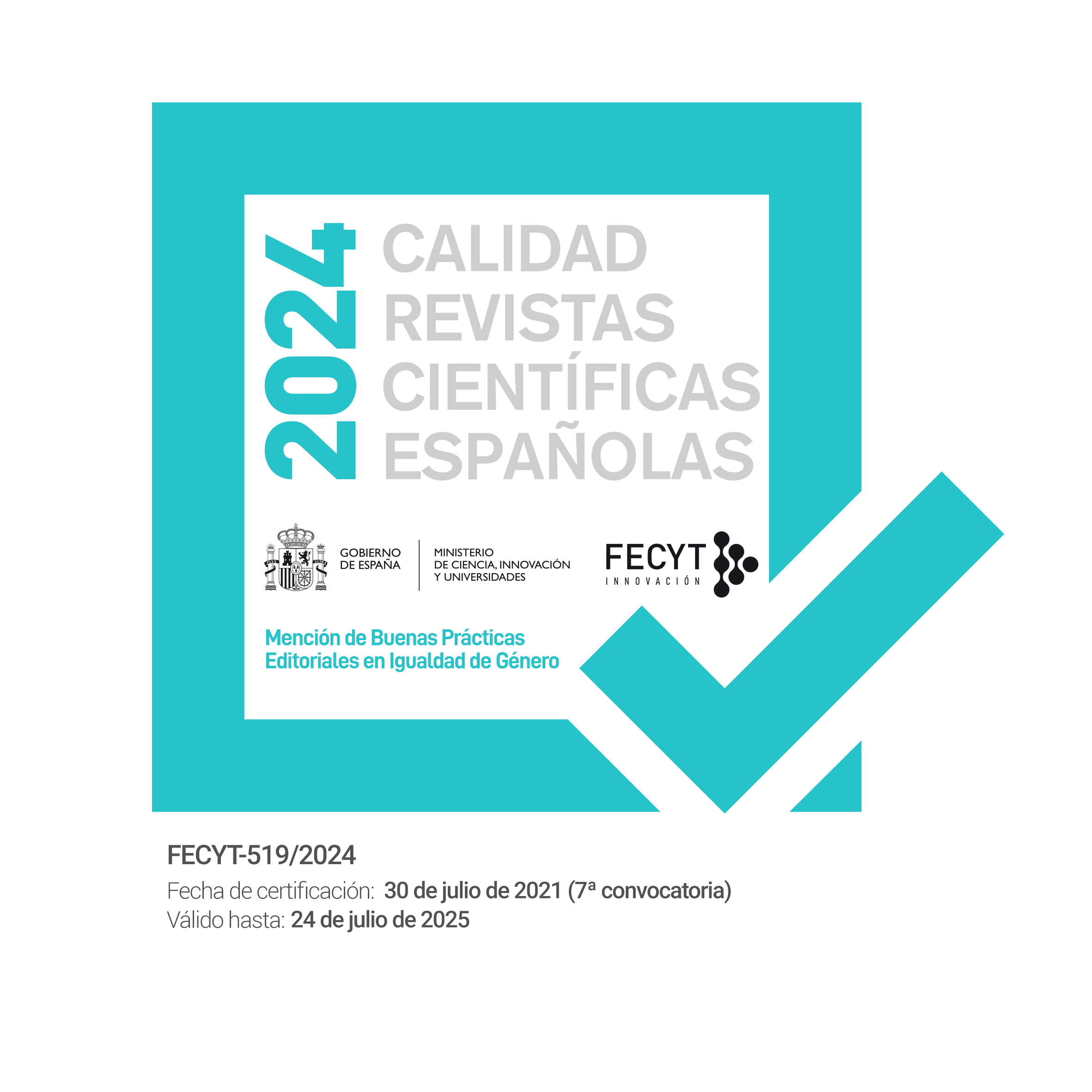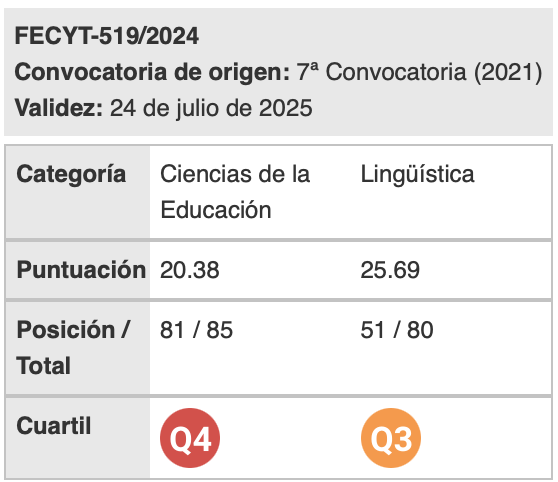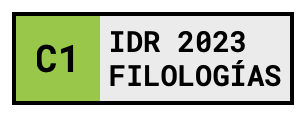The development of intercultural communication competence through cultural learning in textbooks
Keywords:
intercultural communication, language teaching, textbooks, culture, cultural learningAbstract
Nowadays we live in an intercultural society and this should imply a revision of the language learning approach. Since a good level of linguistic competence does not guarantee successful communication, many scholars have turned to intercultural communicative competence (ICC), a trend reinforced by the Common European Framework of References for Languages (2001). Textbooks are the most important tool for the foreign language teacher (Sercu, 2000). Thus, it should be analyzed whether books are effective for cultural learning as part of ICC development. Following Paige (1999) and Lee (2009), we have designed an itemized three-category model (Culture in general, “big C” culture” and “small c” culture) to analyze three B2-level English textbooks. Using this model, we have recorded a number of incidences per item and per category in each book, differentiating between productive and receptive skills (speaking, writing, listening and reading). At the end of this paper, the results will be discussed regarding the different textbooks, categories and skills, highlighting the most relevant information in each case.
DOI: 10.20420/rlfe.2015.0001
Downloads
References
Aleptkin, C. (2002). Towards Intercultural Communicative Competence in ELT. ELT Journal, 56 (1), 57-64.
Areizaga, E. (2002). El componente cultural en la enseñanza de lenguas: elementos para el análisis y la evaluación del material didáctico. Cultura y Educación, 14 (2), 161-175.
Bennett, J., Bennett, M., y Allen, W. (2003). Developing intercultural competence in the language classroom. En L. Dale, R. Lange y M. Paige (Eds.) Culture as the core: Perspectives in second language learning. Greenwich, CT: Information Age.
Byram, M. (1989).Cultural Studies in Foreign Language Education. Clevedon, U.K.: Multilingual Matters.
Byram, M. (1997). Teaching and assessing intercultural communicative competence. Clevedon: Multilingual Matters.
Byram, M. (2000). Assessing intercultural competencein language teaching. Sprogforum, 18, 8–13.
Byram, M. (ed.) (2001). Languages for Intercultural Communication and Education, 1: Developing Intercultural Competence in Practice. Clevendon: Multilingual Matters Limited.
Consejo de Europa (2002). Marco de Referencia Europeo para el Aprendizaje, la Enseñanza y la Evaluación de Lenguas. Madrid: Instituto Cervantes.
Cortazzi, M. y Jin L. (1999). Cultural Mirrors, Materials and Methods in the EFL Classroom. En E. Hinkel (Ed.), Culture in Second Language Teaching and Learning. Cambridge: Cambridge University Press.
Council of Europe (2001). Common European Framework of Reference for Languages: Learning, Teaching, Assessment. Cambridge: Cambridge University Press.
Deardorff, K. (2006). Identification and assessment of intercultural competence as a student outcome of internationalization. Journal of Studies in International Education, 10, 241–266.
Genc, B. y E. Bada (2005). Culture in Language Learning and Teaching.The Reading Matrix, 5(1), 73-84.
Göbel, K. y Helmke, A. (2010). Intercultural learning in English as foreign language instruction: The importance of teachers’ intercultural experience and the usefulness of precise instructional directives. Teaching and Teacher Education, 26, 1571-1582.
Hendson, U. S. (2005). The interaction of language and culture: new views in foreign language teaching. In W. Gehring (Ed.), Kulturdidaktikim Englischunterricht. Oldenburg: Universität Oldenburg.
Hofstede, G. (2001). Culture’s consequences: Comparing values, behaviours, institutions and organizations across nations. Thousand Oaks, CA: Sage Publication.
Holliday, A., Hyde, M., y Kulman, J. (2004).Intercultural Communication: An advanced Resource Book. London: Routledge.
Hyde, M. (1998).Intercultural Competence in English Language Education. Modern English Teacher, 7(2), 7-11.
Kramsch, C. (1993). Context and Culture in Language Teaching. Oxford: Oxford University Press.
Kramsch, C. (1998). El privilegio del hablante intercultural. En M. Byram y M. Fleming (Eds.) Perspectivas Interculturales en el Aprendizaje de Idiomas. Cambridge: C.U.P.
Lakoff, G. (1987). Women, Fire and Dangerous Things. What Categories Reveal about the Mind. Chicago: University of Chicago Press.
Larzen-Osternmark, E. (2009). Language teacher education in Finland and the cultural dimension of foreign language teaching – a student teacher perspective. European Journal of Teacher Education, 32, 401-21.
Lee, K. (2009). Treating culture: What 11 high school EFL conversation textbooks in South Korea do. English Teaching: Practice and Critique, 8 (1), 76-96.
Lee, K. (2012). Teaching intercultural English learning/teaching in world Englishes. English Teaching: Practice and Critique, 11(4), 190-205.
Liaw, M. (2006). E-learning and development of intercultural competence. Language Learning and Technology, 10 (3), 49-64.
Mitchell, R., & Myles, F. (2004).Second language learning theories. London: Arnold.
Novinger, T. (2001). Intercultural Communication: A Practical Guide. Austin: University of Texas Press.
Paige, R., Jorstad, J., Paulson, L., Klein, F., y Colby, J. (1999). Culture learning in language education: A review of the literature. En R. Paige, D. Lange, y Y.Yershova (Eds.), Culture as the core: Integrating culture into the language curriculum. Minneapolis, MN: The Center for Advanced Research on Language Acquisition, University of Minnesota.
Paricio, María S. (2005). La dimensión cultural en los libros de texto de lenguas extranjeras; pautas para su análisis. Glosas didácticas, 15, 133-144.
Pusch, M. y La Brack, B. (2003). Professional Practice Workshop: Fundamentals of Intercultural Communication. Portland: Association of International Educators, Professional Development Program.
Rajagopalan, K. (2004). The concept of world Englishes and its implication for ELT. ELT Journal, 58(2), 111-117.
Risager, K. (1998). Language teaching and the process of European integration. En M. Byram, y M. Fleming (Eds.), Language Learning in Intercultural Perspective. Cambridge: Cambridge University Press.
Rodrigo, M. (1999). La comunicación intercultural. Barcelona: Anthropos.
Sapir, E. (1958). Culture, Language and Personality. Berkeley, CA: University of California Press.
Scheu, D. (2005). Linguistic and cultural relativity in foreign language education. En W. Gehring (Ed.), Kulturdidaktikim Englischunterricht. Oldenburg: Universität Oldenburg.
Sercu, L. (2000). Textbooks. En Routledge Enciclopedia of Language Teaching and Learning, Byram, M. (ed.). Londres: Routledge.
Sercu, L. (2005). Teaching foreign languages in an intercultural world. En M. Byram y A. Phipps (Eds.), Foreign language teachers and intercultural competence. Buffalo, NY: Multilingual Matters, Ltd.
Varón Páez, M. (2009).Componente cultural, libros de texto y enseñanza del inglés como lengua extranjera. Forma y Función, 22 (1), 95-124.
Vez, J. M. (2001). Formación en didáctica de las lenguas extranjeras. Rosario, Argentina: Homo Sapiens.
Vilà Baños, R. (2004). Una actividad telemática para el desarrollo de la competencia comunicativa intercultural de adolescentes. En E. Soriano (Coord.), Recursos para la Enseñanza y Aprendizaje de la Educación Intercultural. Almería: Universidad de Almería.
Vilà Baños, R. (2005). La competencia comunicativa intercultural. Un estudio en el Primer Ciclo de la ESO. Tesis Doctoral. Barcelona: Universitat de Barcelona.
Ware, P., & Kramsch, C. (2005). Toward an intercultural stance: Teaching German and English through telecollaboration. The Modern Language Journal, 89(2), 190-205.
Weaver, G. (1986). Understanding and coping with cross-cultural adjustment stress. En R. M. Paige (Ed.),Cross-Cultural Orientation: New Conceptualizations and Applications. Lanham, MD: University Press of America.
Widdowson, H. G. (1998). Context, Community and Authentic Language. TESOL Quarterly, 32(4), 705-716.
Downloads
Published
How to Cite
Issue
Section
License
Authors who publish with this journal agree to the following terms:
- Authors retain copyright and grant the journal right of first publication with the work simultaneously licensed under a Creative Commons Attribution License that allows others to share the work with an acknowledgement of the work's authorship and initial publication in this journal.
- Authors are able to enter into separate, additional contractual arrangements for the non-exclusive distribution of the journal's published version of the work (e.g., post it to an institutional repository or publish it in a book), with an acknowledgement of its initial publication in this journal.
- Authors are permitted and encouraged to post their work online (e.g., in institutional repositories or on their website) prior to and during the submission process, as it can lead to productive exchanges, as well as earlier and greater citation of published work (See The Effect of Open Access).

Revista de Lenguas para fines específicos is licensed under a Creative Commons Reconocimiento-NoComercial-SinObraDerivada 4.0 Internacional License.
























